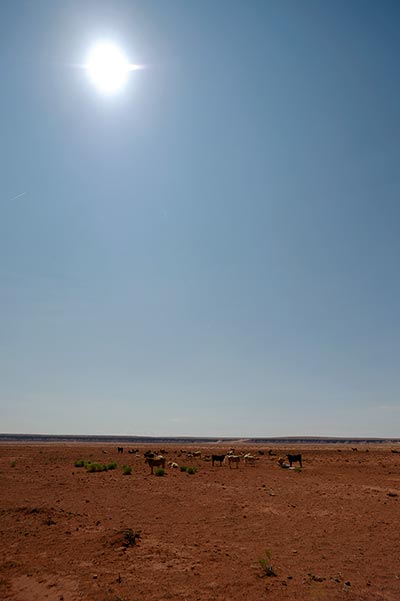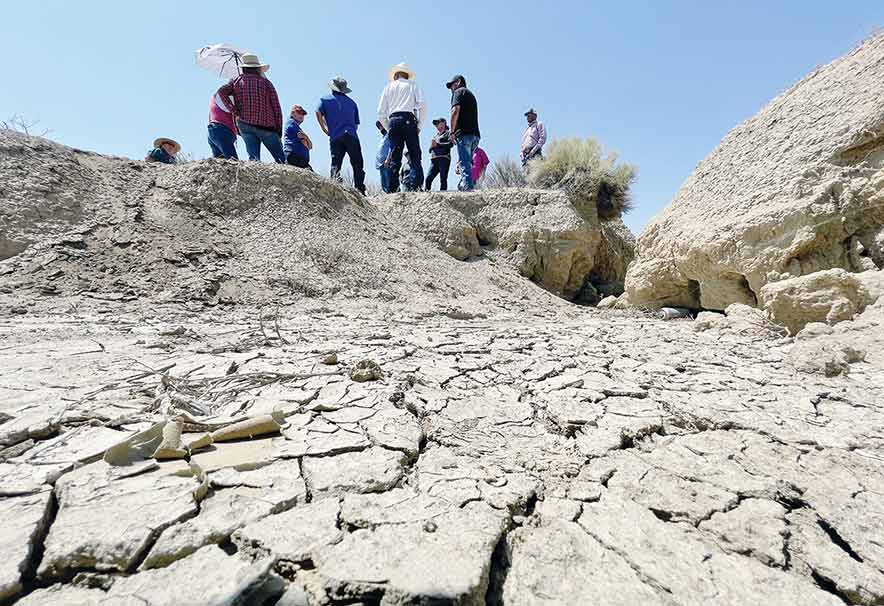
Top 10 Stories of 2021 | No. 6: Water shortages, drought persist
By Donovan Quintero and Krista Allen
Navajo Times
WINDOW ROCK

Navajo Times | Donovan Quintero
A herd of cattle lie next to an empty water trough July 15 along U.S. Highway 64 east of Kayenta.
Drought continues to exacerbate the lack of moisture that has impacted the Navajo Nation for more than 20 years.
A mega drought has had the reservation in its grip, creating a water shortage.
In July, the Resources and Development Committee, headed by Delegate Rickie Nez, went on a drought tour. They learned two lakes, in Ganado and Many Farms, were on the verge of completely drying out.
Carlee McClellan, a senior hydrologist with the Navajo Department of Water Resources, identified and explained the four types of droughts – hydrologic, agricultural, meteorological, and socio-economic – to RDC members Nez, Mark Freeland, Kee Allen Begay and Herman Daniels Jr.
He added the droughts needed to be addressed if the tribe wanted to conserve water.
“I think it’s going to be a really, really great idea to think outside the box,” McClellan said. “And what I mean by that is we are out here, meeting with the people, and we’re meeting to see what the grassroots issues and concerns are, to see what the issues are from the bottom up.
“But then, we also need to do a top-down approach and meet with scientists, meet with engineers,” he said.
Rainless climatic conditions are not a new phenomenon to the Diné. Centuries of drought, lasting decades at a time, including the current human-caused drought that has been hovering over the reservation for more than 20 years, have taken a toll on Diné country.
Enactments of U.S. policies, like Bureau of Indian Affairs Commissioner John Collier’s New Deal, also wreaked havoc, which was supposed to improve the lands by forcing Navajos to reduce livestock.
Top 10 Stories of 2021: No. 6
The RDC identified overgrazing as one of the core causes of dire conditions on the reservation.
Almost 90 years after Collier introduced the sheep reduction program, Nez and Freeland favored reduction. During the tour, they learned how drought and overgrazing were making profound changes across the Nation.
A heatwave in June with temperatures above 100 degrees for many parts of Diné Bikéyah caused a water shortage restriction to be issued by the Navajo Tribal Utility Authority, telling its watering station users they needed to reduce their water usage to 500 gallons a week, until further notice.
Rex Kontz, deputy general manager for NTUA, said a 500,000-gallon water tank in Dilkon was reduced to a couple of feet.
Since the restriction was issued, he said the levels were back to normal.
Kontz said the tribe had immediate access to 101,500 acre-feet of water, or more than 33 billion gallons of water, annually, through the New Mexico and Utah water rights settlements. Settlements with Arizona have not been decided.
Reservoirs could be constructed to hold the tribe’s water. The stored waters could then become lakes that could serve not only as a drinking source for people, wildlife and livestock, but could become recreational areas that could boost the economy for the tribe and communities like Tséʼałnáoztʼiʼí.
Bathtub rings
Rivers are often seen as nature’s lifeline.
That’s certainly true in Tooh Bikooh, which supplies water to 40 million people and irrigates five and half million acres of farmland in seven states.
This year a record-smashing drought, the latest in a two-decade long megadrought, fallowed alfalfa fields in Colorado and left boat ramps and bathtub rings in Lake Powell.
Lake Mead, the largest reservoir in the U.S., fell to a record low, triggering water restrictions across Arizona and Nevada.
The bathtub rings on Lone Rock near the Arizona-Utah border records how far the water level has fallen in Lake Powell.
Inflow from Tooh Bikooh has been below average every year but five since 2000, when the Western U.S. entered the beginning of the megadrought triggered by a combination of a natural dry cycle and human-caused climate change that’s sucking water from the West’s rivers.
Powell was at less than half capacity in January 2019. The water in Powell in mid-August was 31.47% of full pool (24.3 million acre feet).
The highest water level recorded was in July 1983, when the water swelled the banks of the lake and river in every direction across the semi-arid landscape.
The lowest level recorded was this year, reaching a low of 3,550.96, a level that had not been seen since April 26 and 27, 1969, when the reservoir was still filling after the construction of Dá’deestł’in Hótsaa in 1963.
When Lake Powell is full (elevation 3,700 feet above sea level), it extends 186 miles up Tooh Bikooh and 75 miles up the San Juan, Tooh Bika’í, creating 1,960 miles of winding canyon shoreline.
The Navajo Times reported in September that while the reservoir is sinking to its lowest level ever because of extreme drought, it doesn’t mean the lake is closed.
Page Mayor Bill Diak told the Times that looking at the water levels and the way they were receding, there would be some critical situations with access.
Lake Powell has 11 launch ramps. Six are partially open and one, the Antelope Point Valet Launch Ramp at Jádí Tó, is fully functional.
Diak said maintaining access at Wahweap Bay, the busiest visitor area, is crucial for Page.
Diak said there was still water in the reservoir, but it was getting harder to access.
“The lake still has a lot of water in it,” he said at the time. “It’s not empty. Although some people put information out there that ‘Lake Powell is drying up.’ Well, it’s not.”
Dry year

Navajo Times | Donovan Quintero
Officials from various Navajo Nation departments do a drought tour with the Resources and Development Committee on July 16, 2021, in Huerfano, N.M.
The long-running dry stretch rivals anything in the last several hundred years, a sign of climate change.
Water levels usually peak and snowpack melts and courses to the reservoirs. But this year in Diné Bikéyah, drought was strong but not enough to overwhelm Michael Bia and his mother.
The pair were up on Navajo Route 13 and filled their 275-gallon water tank with artesian water on a warm day in July.
Bia stood on the back the pickup truck holding four-inch PVC tubing, about 10 feet in length. He said it takes about 45 minutes to an hour to fill the tote, which they use for themselves and for livestock.
“As far as I know, we’ve been getting the water all my life,” Bia said. “I’m 35 years old, so for 35 years, ever since I was born.”
Bia said he’s been drinking the water all his life. His mother, who did not want to give her name, agreed.
“It’s pretty good tasting water,” she said.
The pair say they haul water up to twice a day. They don’t always get water from the natural flow from the Chuska Mountains. But since it’s free, they said they go there often to fill up their tank.
Bia’s mother said she’s been driving up to the mountain all her life to get water.
“We don’t have running water or an artesian well,” she said. “We don’t get our water from here all the time.”
Sometimes they get their water from the Lukachukai Chapter, but lately the water doesn’t taste right. Even her livestock notice the taste and do not drink it, she added.
“Sometimes the water is yellow,” she said, referring to the chapter’s water.








 Highway 264,
Highway 264, I-40, WB @ Winslow
I-40, WB @ Winslow